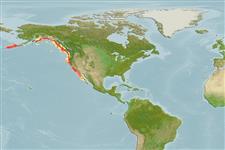Pycnogonida |
Pantopoda |
Phoxichilidiidae
Environment: milieu / climate zone / depth range / distribution range
Ecology
Benthic; depth range 155 - 2743 m (Ref. 2157). Subtropical
Pacific Ocean: USA and Alaska.
Length at first maturity / Size / Weight / Age
Maturity: Lm ? range ? - ? cm
Have two Laterodistal projections of ocular tubercle; relatively short proboscis 0.6 as long as anterior trunk segment. Abdomen short and legs bear randomly placed spines modest and not larger than sole spines. Oviger moderately setose, and male cement gland tube equal in length to femoral diameter (Ref. 2157, p. 5).
Slope to abyssal (Ref. 19).
Life cycle and mating behavior
Maturity | Reproduction | Spawning | Eggs | Fecundity | Larvae
Members of the class Pycnogonida are gonochoric and sexually dimorphic. During copulation, male usually suspends itself beneath the female. Fertilization occurs as the eggs leave the female's ovigers. Males brood the egg masses until they hatch. Life cycle: Eggs hatch into protonymphon larva then to adults.
Child, C.A. 1996 The Pycnogonida types of William A. Hilton. II. The remaining undescribed species. Proceedings of the Biological Society of Washington 109(4):677-686. (Ref. 2117)
IUCN Red List Status
(Ref. 130435: Version 2025-1)
CITES status (Ref. 108899)
Not Evaluated
Not Evaluated
Threat to humans
Human uses
| FishSource |
Tools
More information
Trophic EcologyFood items (preys)
Diet composition
Food consumption
Predators
Population dynamicsGrowth
Max. ages / sizes
Length-weight rel.
Length-length rel.
Length-frequencies
Mass conversion
Abundance
Life cycleReproductionMaturityFecunditySpawningEggsEgg developmentLarvae PhysiologyOxygen consumption
Human RelatedStamps, coins, misc.
Internet sources
Estimates based on models
Preferred temperature
(Ref.
115969): 2.7 - 5.5, mean 3.8 (based on 68 cells).
Price category
Unknown.
